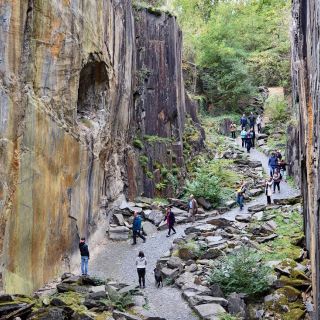
Lascaux IV, world centre of cave art
Just 40 minutes from Brive, Lascaux IV offers a mystical and playful plunge into prehistory that will appeal to young and old alike.
Situated in the heart of the Vézère Valley in Montignac, Dordogne, the Montignac-Lascaux International Centre for Cave Art reproduces the Lascaux cave in its entirety. It also uses new image and virtual technologies to showcase and popularise cave art in general. An unmissable visit near the Brive basin!
5 good reasons to visit Lascaux IV
- Marvel at the complete reproduction of the original cave.
- Immerse yourself in the atmosphere of a real cave by using all five senses.
- Take on the role of Cro-Magnon and (virtually) test your painting techniques in the "L'Atelier" in Lascaux.
- Admire the view over the Vézère Valley from the Belvedere on the roof of Lascaux IV.
- You can also visit Lascaux II, the first stone in the construction of the Montignac-Lascaux International Centre for Cave Art.
The history of the Lascaux cave
How was the Lascaux cave discovered?
Did you know? The real discoverer of the Lascaux cave was... a dog! On 8 September 1940, young Marcel Ravidat was out for a walk with Robot, his faithful four-legged companion. The canine found a hole and slipped inside. Intrigued, his master threw a pebble in and realised that the crevasse was much deeper than it appeared.
On 12 September, he returned to the site with three friends. Together, they decided to widen the gap, then slipped inside. There, by the light of a simple lamp, they made one of the most important archaeological discoveries of the 20th century: cave paintings drawn by Cro-Magnon man!
The site was quickly taken over by the scientific community. It was not opened to the public until 1948.

The Lascaux cave listed as a UNESCO World Heritage Site
The Vézère Valley represents over 400,000 years of human occupation. It boasts an exceptional concentration of archaeological and prehistoric sites of worldwide interest, with almost 150 sites and around thirty decorated caves.
In 1979, 15 of these sites, which were used for funerary rites, housing or hunting, were classified as World Heritage Sites by UNESCO. The Lascaux cave is one of these marvels.
Why four Lascaux?
As if one Lascaux wasn't enough, there are now four. But why? Quite simply because the original cave (or Lascaux I) has been off-limits since 1963. Over the years, far too many visitors have caused irreversible damage to the walls.
But in order not to deprive the public of this priceless masterpiece, a facsimile project was launched in the early 1970s. The first model recreating the Hall of the Bulls was presented in 1980 at the Grand Palais in Paris.
Lascaux II opened in 1983 in Montignac. It was built underground on the same hill as Lascaux I, but only reproduced a small part of it.
In 2012, Lascaux III came into being. This is a facsimile in the form of a travelling exhibition that can travel to the four corners of the world.
Finally, Lascaux IV was born in 2016.
What is Lascaux IV?
Lascaux IV, or the Montignac-Lascaux International Centre for Cave Art, is a tourist centre dedicated to the history of the Lascaux cave and to cave art around the world.
It took the Ateliers des Fac-similés du Périgord three years of work to recreate the cave on a scale of 1 in its entirety and in an intact atmosphere. Smells, humidity, subdued lighting: everything has been brought together to make you feel as if you were in the original cave.
A digital area even gives you access to some of the works in augmented reality, so you can discover them in greater detail.
And here's an important detail: the visit is accompanied by a "companion", i.e. a tablet in your hand and headphones on your ears for even greater immersion. The Lascaux cave has entered the digital age!

Tip You will go to Lascaux

Around 17,000 years ago, in a part of the world not yet known as the Périgord or the Dordogne, Cro-Magnon man was busy painting animals on the walls of a cave now known as the Lascaux cave. A fine piece of work, to say the least, and it would be a great shame for you, homo turisticus, to leave the region without contemplating the cave nicknamed the "Sistine Chapel of prehistory".
International Center for Cave Art
Route de Lascaux,
24290 Montignac
05 53 50 99 10
Practical information
How do I get to Lascaux IV?
The Lascaux IV site is located in the commune of Montignac, in the Dordogne, around 40 km from Brive, 25 km from Sarlat and 55 km from Périgueux. It takes around 40 minutes to get there by car from Brive.
Coming without a car?
From Brive-La-Gaillarde, you can take the bus to Montignac, 2 km from Lascaux. See our regularly updated "Visiting without a car" section and download the document.
Things you should know before visiting Lascaux IV
- Pets are not allowed (except guide dogs).
- Pushchairs are not allowed: bring a baby carrier for small children.
- Picnics are not permitted on site. Food and drink are not permitted in the building.
- Bring warm clothing as the temperature inside the facsimile does not exceed 13°C.
- The tour route is suitable for people with reduced mobility.
- The visit must be accompanied by a cultural mediator. Duration: 1h30.
- Photographs are not permitted inside the facsimile.
Services available on the Lascaux IV site
Free car parks (car, camper van, bus) - recharging points for electric cars - on-site catering for a fee - free wifi - souvenir shop. For opening times, prices and tour bookings, visit the Lascaux IV website here.

Share this article
Or share the link
You will also like...




